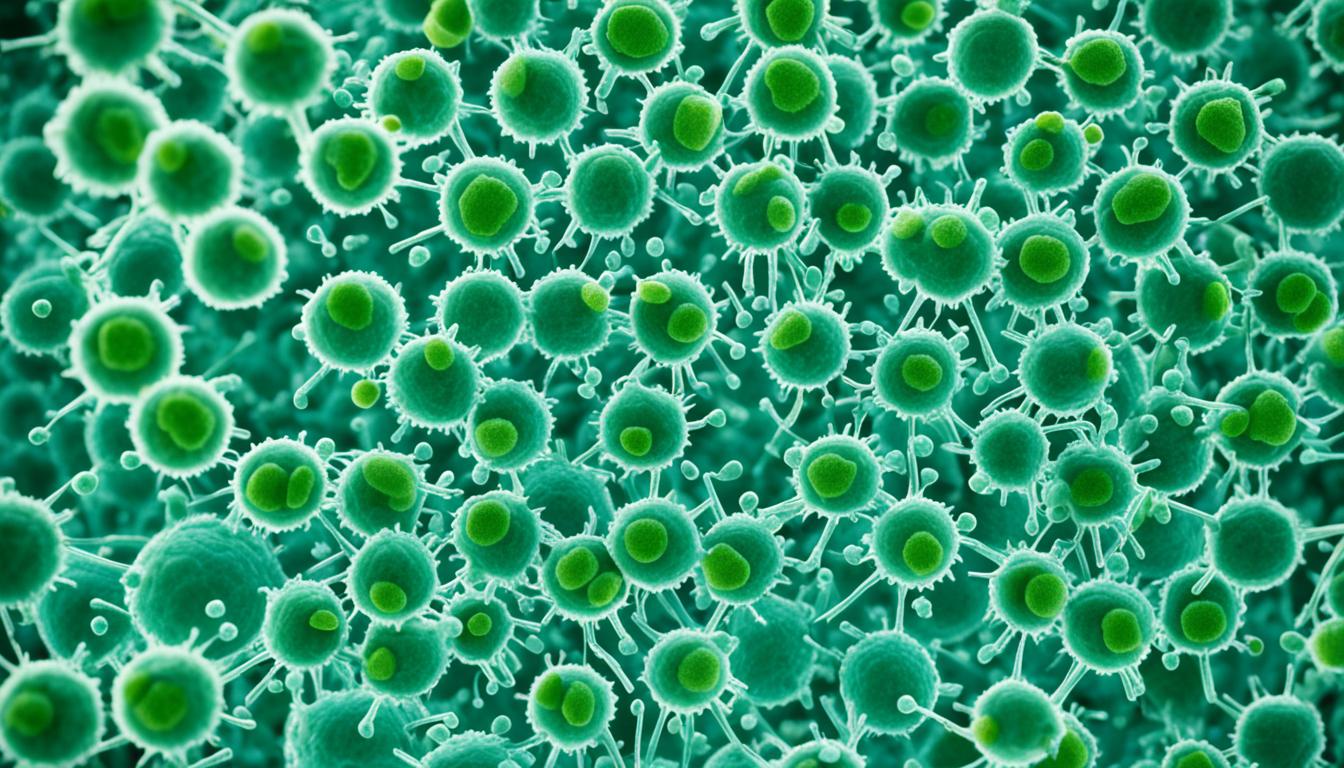Bunyaviruses are a group of viruses. They belong to the Bunyavirales order. There are several types, including Orthonairovirus and Phlebovirus. These viruses can lead to a variety of diseases in humans.
Illnesses range from mild flu symptoms to serious ones such as encephalitis and hemorrhagic fever.
Fevers, headaches, and body aches are common with bunyavirus infections. You might feel very tired and even see bleeding in some cases. These viruses spread through the bites of infected bugs like mosquitoes and ticks.
To avoid getting infected, use insect repellent and wear clothes that cover your skin. Try to get rid of places where mosquitoes breed. Right now, there are no special medicines or vaccines for these viruses.
But, scientists are working on finding new ways to treat bunyavirus diseases. Stem cell therapy is one of the methods showing hope in this area of research.
Key Takeaways:
- Bunyaviruses are a group of viruses that can cause a range of diseases in humans.
- Common symptoms of bunyavirus infections include fever, headache, body aches, fatigue, and bleeding.
- Bunyaviruses are transmitted through the bite of infected mosquitoes, ticks, or other arthropods.
- Prevention strategies include using insect repellents, wearing protective clothing, and eliminating mosquito breeding sites.
- Research is ongoing to develop novel therapies, including stem cell therapy, to combat bunyavirus infections.
Bunyaviruses: A Neglected Group of Viruses
Bunyaviruses are viruses often overlooked by many, despite their serious health risks. For example, three of them, CCHFV, LASV, and RVFV, are top concerns for the World Health Organization. This shows just how important they are for public health.
Yet, bunyaviruses don’t get as much research attention as other viruses do. Because of this, we don’t have many ways to prevent or treat bunyavirus infections.
We really need to put more money and effort into studying these viruses. Doing this could help us fill in the gaps in our knowledge. It could also lead to better ways to stop and treat these infections.
Scientists are aiming to create medicines that could fight off more than one kind of bunyavirus. This is a big step forward in bunyavirus research. It gives us all hope for beating these viruses in the future.
Bunyaviruses: Insights into Viral Biology and Host Interactions
Learning about bunyaviruses’ biology and how they interact with cells is key to fighting them. These viruses have a unique genome inside a lipid layer. This lets them quickly change and survive in different places. By understanding how they pack their genome, we can find ways to stop them.
Bunyaviruses have special proteins that help them hide from our immune system and make more viruses. These non-structural proteins change how our cells work. They help the virus stay undetected and make our cells work for the virus.
Cell parts are also important for bunyavirus growth. They help the virus make more copies and can make the illness stronger. Figuring out how cells and viruses work together will give us clues on stopping the virus.
When we get sick with a virus, our body makes a special response to fight it. But, bunyaviruses have ways to stop our body from fighting back. They can turn off parts of our defense system, which helps them grow more.
To stop bunyaviruses, we must understand their complex relationship with our cells. This includes how they pack their genome, hide from our immune system, and stop our defense. Finding these answers will help us create new ways to fight them and help our body defend itself better.
Interactions between Bunyaviruses and Host Cell Factors
| Bunyavirus | Host Cell Factors | Functions |
|---|---|---|
| Hantavirus | Integrins | Facilitate viral entry into host cells |
| Orthobunyavirus | Proteasomes | Modulate viral protein degradation and intracellular trafficking |
| Nairovirus | Host RNA helicases | Aid viral RNA replication and structure formation |
| Phlebovirus | Host chaperones | Facilitate proper folding and stability of viral proteins |
Note: The table above provides a glimpse into the interactions between bunyaviruses and host cell factors. These interactions are multidimensional and involve various host factors, including but not limited to the ones listed in the table.
We should keep studying to find more cell parts that help the virus. Knowing all parts involved can help us target the virus directly. Also, understanding how the virus avoids our immune system can help us make better defenses against it.
Conclusion
Bunyaviruses are a big concern for everyone’s health and are known to cause serious diseases. These viruses are on the World Health Organization’s list of top diseases. But researchers are still learning about them. This means we don’t have solid ways to stop them.
Yet, scientists are making progress. They are looking into new medicines and how to use stem cells to fight these viruses. Learning more about how the virus and our bodies interact helps. It shows us ways to fight back against bunyaviruses.
With diseases like these on the rise, it’s more important than ever to study bunyaviruses. Doing so can help us be ready to stop a big outbreak. By understanding them better, we can be ready for any future virus scares.
To wrap up, putting money into virus research and health plans helps a lot. It lets us learn more about bunyaviruses and find ways to keep us safe. With everyone working together, we can keep our world healthy and happy.

